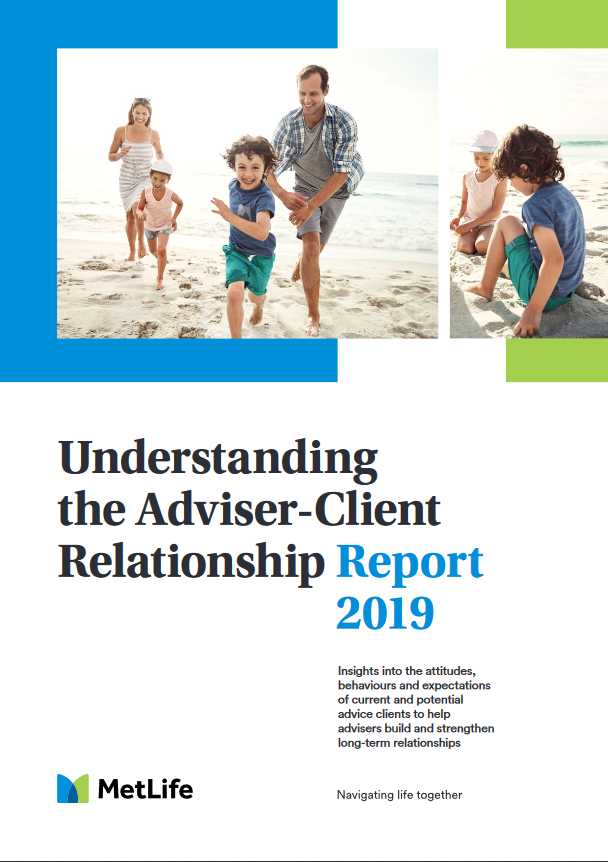- Less than 20% (69%)
- Up to 20% (10%)
- Up to 40% (8%)
- Not sure (5%)
- Up to 100% (5%)
- Up to 60% (4%)
Our latest poll stems from newly-released research which suggests there’s a growing number of consumers who are interested in fees as an alternative payment structure for risk advice.
 This potentially significant finding is contained in MetLife Australia’s ‘Understanding the Adviser-Client Relationship Report 2019’ (see also: Advisers Should Consider Multiple Relationship Structures…)
This potentially significant finding is contained in MetLife Australia’s ‘Understanding the Adviser-Client Relationship Report 2019’ (see also: Advisers Should Consider Multiple Relationship Structures…)
Historically, advisers have contended that a specialist or risk-focussed advice business proposition cannot survive without access to remuneration via commissions. This may still be the case, but in more recent times, the industry has witnessed risk advice businesses which have started charging fees for the SoA element of their advice services, while these and other advice practices have also developed a fee proposition for serving their clients at claim time.
The challenge of developing a fee-based business proposition for life insurance advice – effectively replacing remuneration by risk commissions – has always been contentious and until very recent times has also been largely hypothetical.
Has consumer thinking evolved in 2020 to the point where charging fees for risk advice is – at the very least – not out of the question? Or do you think the findings in MetLife’s ‘Understanding the Adviser-Client Relationship Report‘ in relation to fees and commissions will remain theoretical and outside commercial realities?
Tell us what you think and we’ll report back next week…





This would be accurate results if the consumers were asked the following:-
Would you be prepared to pay and upfront advice fee if the longer term outcome was lower overall cost?
I suspect for some the answer would be yes and some No, but at least the data would not be skewed to advisers who have a vested interest.
There is a difference between asking Australians if they would pay a fee for Insurance advice and asking them to pay for all the work, of which, advice is a small component of all the work required.
The Life Insurance Industry is hamstrung with systems, processes, administration and documentation that creates confusion and inefficiencies, which adds to the cost of providing advice.
It does not matter what a person in an Institution says, who has never run their own specialist Risk advice practice, employing advisers and staff, with all the associated costs and risk, as they are theorists with insufficient capability to push this agenda.
This rehashed rubbish of a willingness to pay fees, has been shot down conclusively and must be stomped on every time a purveyor of these fantasies pops their head up without telling the full story.
Still troubled by the carnage that’s been imposed on advisers over the last 4-5 years during the Christmas break, I had the opportunity to speak to a partner of an accounting firm in South Melbourne last week about all the upheaval the industry is suffering with and I asked her about customers paying fees. I think she summed the situation up perfectly.
She explained her practice only works with high net worth clients and that they DO work on a fee for service basis already but even she struggles to ‘convince’ her wealthy clients to pay $1,500 for an advice document. If wealthy clients won’t pay for the advice – how do these so-called industry geniuses, who sit up in their bell towers and have no face to face experience, expect the average mum and dad punter too?
This is yet more proof the theorists have no clue what really goes on in this industry or how consumers really perceive the work advisers do – which is now more onerous and painful than its ever been for less money than many of us have ever earnt.
Another problem with the question is that we don’t know of those advisers who charge a fee for Life Insurance advice, are also charging for other services, such as financial planning advice. Maybe the question could have been worded “Assuming you derive no other income from your clients, what proportion of your clients do you estimate would be prepared to pay a fee for Life Insurance advice only?”, or something similar.
How does an offer of “long term lower cost” even remotely sound valid.
You don’t even know what the long term premiums are going to be so putting out a statement that the client will have long term premium savings based on a fee for service provides … no guarantees !
What’s a long term cost saving translate to in years.
Most risk policies do not stay on the books longer than 8 years, which is why they are often reviewed due to better contract conditions being offered at a more competitive price.
The reason is obvious and has been in operation ever since Noah built the ark.
Life companies in order to get new business have always offered better premium and sometimes better contract terms to new clients than they have to their existing clients.
In a practical terms though, on the assumption that commissions are rebated, the discount in year 1 to a client is 30.0%.
So if the 30.0% rebate on premium of say a $3,000 is replaced by a fee for advice, the clients initial premium is $2,100.
So what’s the initial fee then charged for the advice ?
On current commission levels it should be around $1800 (60.0%)
That translates to an hourly charge of $200 per hour based upon a 9 hour start to finish time frame in preparing and presenting the advice and acceptance by the life company.
So the proposal being called long term cost savings will require a client to pay $3,900 for something that would have cost them $3,000.
It’s a stretch to expect the client to think they are getting a 30.0% discount and then having to pay 30.0% more based upon a fee for service proposition.
Next, lets look at the renewal fee for service review charge.
Assuming it stays at $200 per hour, you’d expect the fee to be equal to at least a 2 hour charge of say $400 unless you decide that your review charge has a minimum of $600.
Does the 30.0% discount continue after year 1 or does normal rate for age, CPI and general stepped premium increases,… prevail ?
Yes, it less than the 20.0% renewable commission that would have been paid.
So the adviser is now earning 33.0% less on a fee for service basis, if the $400 review fee for service is charged.
If you don’t write much risk business, then the discrepancy of losing 33.0% of renewal payments per annum will not bother your bottom line or will it ?
I haven’t been able to figure out what the long term premium cost savings are because I don’t know what the risk premiums are going to be in 3 years, 5 years or even 10 years and neither can any other adviser because none of the premium illustrations and long term projections are guaranteed.
The other aspect of charging fees for insurance advice, is what do you charge when the claim occurs?
Lump sum claims, other than TPD, are often simple, over and done with quickly. But how do you charge for ongoing assistance with Income Protection and Business Expenses claims?
In these scenarios, the client’s income is usually reduced, there expenses often increase. Can they afford to pay for your time to assist them at their most needy?
In my Practice, I have always promoted that the commissions received covers my advice and assistance at claims times. It’s a pooled service, like the basics of insurance itself. Everyone pays for claims assistance, but not everyone needs it. When you do, I’ll be there and you won’t be charged anything over and above the premiums that you have paid.
Let’s have insurance under fee for service AND world peace. Both sound pretty easy.
Spot on Ha Ha
Who keeps coming up with this stuff ??? A poll can be set up in any number of ways to push for a certain reaction and result
How about Risk Info publish a list of questions from us advisers and go out and ask the man on the street about what they think. Would you pay a fee for service knowing your adviser can get paid 60% from the insurance company based on the premium you pay. This is not enough for the work required so can you pay an additional $$$$$ so i can at least pay the rent this week ? What sort of answers will you get from that i wonder ??
Showing someone what they have to pay in dollars is a whole different thing to simply asking for a fee with no numbers attached.
The questions we ask will not be ambiguous and will extrapolate a definite answer not a quick stab in the dark as the questionnaire they are completing for a $50.00 voucher is getting tiresome now with its 101 questions mostly about nothing !
Maybe AIA or some other company that has done this type of survey would like to enlighten us as to what the content and questions were that they approached the Australian public with ?
Any takers ?
Adviser reliance on research leads to increased research house market power which leads to more complex products, ratings wars and costs which leads to further reliance on research.
Chicken or the egg? Definitely the chickens.
Gotta love a Yank owned company telling us clients prefer to pay fees. Below is article from 2019 US mag.
‘Bob’s insurance company pays a 90/5% commission on whole life policies, which means the selling agent receives 90% of the first year’s premium and 5% of future renewals.’
They’re still selling WoL in USA. Poms banned commissions and now pay ridiculous % of premium amounts per research done by AFSL Synchron.
If you’re like me & over 60 – just sell and get out this disaster of an industry, thanks to ivory tower bureaucrats and over paid under knowledge commissioners. Yes, I’m referring to ASIC. Not to mention ‘lying through their teeth’ life offices who have long ago hedged their bets on how to survive – mainly at the expense of the only people qualified to sell (yes that horrid word) insurance responsibly and to all levels of consumers.
Seriously Matt, up until this article I thought you of all people understood how it works, we have been back at work just over a week and had five new inquires about starting an insurance portfolio, as they were all new inquires we explained what was involved and that they would need to pay a fee of $1,100 up front for us to provide them any advice. Well guess what Matt, all 5 declined the offer and informed us that they were NOT prepared to pay any type of fee on top of the insurance premium. During the same period we finalised 2 new income protection claims, a life claim and a medical trauma claim ( as well a arguing with another insurer about another trauma claim ) all done as part of our ongoing service agreement with clients that have been with us for over 20 years. The reforms are really working aren’t they
How true !and not just you Mark we have had the same results If they can get it direct from Real Insurance { regardless of the issues that may “pop” up” } or other online insurers Why would they pay us ?
What about a client deciding to end the relationship? Your client agrees in the first year to pay your monthly fee (or how ever you charge) but in the second they decide that they want to self manage. They stop paying your ongoing fee and continue on with premiums 30% cheaper than what is available on the market. You are still responsible for the policy (cant remove yourself as the listed adviser), still are notified about missed payment, claims and ongoing admin but don’t receive any ongoing Rem.
I have been a risk only adviser for the best part of 11 years and am in my mid 30’s. Modeling i have created for a fee for service model looks good on paper but implementing in the real world is laughable. laughable in my own head as well as out loud from clients who i have discussed it with. where to from here…. no idea?
Comments are closed.